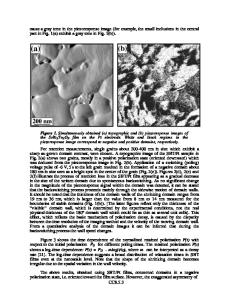An alternative chemical route for synthesis of SrBi 2 Ta 2 O 9 thin films
- PDF / 610,977 Bytes
- 5 Pages / 612 x 792 pts (letter) Page_size
- 25 Downloads / 452 Views
Arau´jo, A.J. Chiquito, and J.A. Eiras Departamento de Fı´sica—Universidade Federal de Sa˜o Carlos, P.O. Box 676, 13560-905 Sa˜o Carlos, SP, Brazil
J.A. Varela Instituto de Quı´mica—Universidade Estadual de Sa˜o Paulo, P.O. Box 355, 14801-970 Araraquara, SP, Brazil (Received 14 February 2000; accepted 5 July 2000)
SrBi2Ta2O9 was synthesized by the modified polymeric precursor method using precursor reagents such as carbonate, nitrate, or oxide. The films were deposited onto Pt/Ti/SiO2/Si(100) substrates by spin coating and crystallized at temperatures ranging from 700 to 800 °C in air. Microstructural and phase evaluation were followed by grazing incidence x-ray diffraction, scanning electron microscopy, and atomic force microscopy. The films displayed rounded grain structures with a superficial roughness of approximately 10 nm. The dielectric constant values were 362 and 617 for films treated at 700 and 800 °C, respectively. The remanent polarization and coercive field were 12.3 C/cm2 and 61 kV/cm and 18.48 C/cm2 and 47 kV/cm for the film treated at 700 and 800 °C, respectively. This method generally allows for the use of readily available reagents such as oxides, carbonates, or nitrate as cation sources, with the added advantage that it requires no special apparatus or atmosphere control. I. INTRODUCTION
SrBi2Ta2O9 (SBT) thin films have been intensively studied as capacitor materials for ferroelectric randomaccess memory (FERAM) devices.1,2 The material belongs to the Bi-layered perovskites originally described by Aurivillus and Fang3 under the formula (Bi2O2)2+(Am−1BmO3m+1) 2−, where A is Bi, Ba, Sr, Ca, Pb, K, or Na, and B is Ti, Nb, Ta, Mo, W, or Fe. SBT thin films are used in nonvolatile memory applications due to the absence of fatigue as opposed to Pbx Zr1−xTiO3 films, which present degradation when they are deposited on Pt electrodes.2 Among the several methods for synthesis of SBT, the most common are pulsed-laser ablation4,5 and sol-gel.6,7 Although laser ablation readily allows for the production of dense and oriented films, controlling the stoichiometry of the film is more difficult. On the other hand, the sol-gel method provides excellent stoichiometric control. The main disadvantage of the sol-gel method lies in the starting precursors, which are normally based on easily hydrolized alkoxides, thus requiring manipulation in a special water-free atmosphere. This study presents a modified route for chemical synthesis of SBT thin films: the modified polymeric precursor method, which is based on the formation of a polymeric resin in which the cations are randomly distributed, leading to a homogeneous inorganic phase. This method has been successfully used in the synthesis of J. Mater. Res., Vol. 15, No. 10, Oct 2000
http://journals.cambridge.org
Downloaded: 17 Feb 2015
several mixed oxides such as SrxBa1−xTiO3, LiNbO3, and SrBi2Nb2O9 (SBN).8,9 The reaction takes place in an ambient atmosphere and the precursors employed are usually reagents such as oxides, carbonates, nitrates, or even alkoxides. T
Data Loading...











